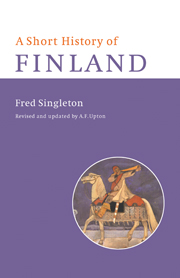Book contents
- Frontmatter
- Contents
- List of maps
- Dedication
- Preface
- 1 HISTORY OF FINLAND
- 2 FINLAND AND SWEDEN
- 3 FINLAND, SWEDEN AND RUSSIA IN THE EIGHTEENTH CENTURY
- 4 THE FINNISH NATIONAL AWAKENING
- 5 THE FINNISH ECONOMY IN THE NINETEENTH CENTURY
- 6 THE POLITICAL DEVELOPMENT OF FINLAND, 1863–I917
- 7 INDEPENDENT FINLAND
- 8 FINLAND IN THE SECOND WORLD WAR
- 9 FINLAND IN THE POST-WAR WORLD: THE POLITICAL SITUATION
- 10 THE ECONOMY OF FINLAND IN THE TWENTIETH CENTURY
- 11 THE SPIRIT OF FINLAND
- Appendices
- Bibliography by John J. Horton
- Index
5 - THE FINNISH ECONOMY IN THE NINETEENTH CENTURY
Published online by Cambridge University Press: 28 January 2010
- Frontmatter
- Contents
- List of maps
- Dedication
- Preface
- 1 HISTORY OF FINLAND
- 2 FINLAND AND SWEDEN
- 3 FINLAND, SWEDEN AND RUSSIA IN THE EIGHTEENTH CENTURY
- 4 THE FINNISH NATIONAL AWAKENING
- 5 THE FINNISH ECONOMY IN THE NINETEENTH CENTURY
- 6 THE POLITICAL DEVELOPMENT OF FINLAND, 1863–I917
- 7 INDEPENDENT FINLAND
- 8 FINLAND IN THE SECOND WORLD WAR
- 9 FINLAND IN THE POST-WAR WORLD: THE POLITICAL SITUATION
- 10 THE ECONOMY OF FINLAND IN THE TWENTIETH CENTURY
- 11 THE SPIRIT OF FINLAND
- Appendices
- Bibliography by John J. Horton
- Index
Summary
During the first half-century of Russian rule the Finnish economy changed little from the position which the Tsars had inherited from the Swedes. The majority of the population depended for their livelihood upon fishing and farming, hunting and trapping, except in some areas where forest-based industries based on the export of timber and tar provided a supplementary income. The import into Britain of what was known as ‘naval stores’ included spars and planking for ships and ‘Stockholm tar’ for caulking. Until the reforms of the 1760s these products had to be exported through Stockholm as the staple port, but thereafter they could be sent directly from Finland to the outside world.
Iron working had a long history, but the iron forges and associated workshops were on a small scale, often organized in paternalistic communities known as ruukit, such as that which was established at Tammisaari (Ekenäs) on the southwest coast. In a typical ruukki the iron master was the overlord of a community of craftsmen and their families. Charcoal was the main fuel and the ores often came from nodules of bog iron recovered from lake beds and marshes. In 1815 there were only 600 workers employed in metal working and both the iron and non-ferrous metal industries had only local importance. There was some expansion in the middle of the century, because the demand for metal goods increased in Russia, and by 1870 the number of metal workers had increased to over 3,000.
- Type
- Chapter
- Information
- A Short History of Finland , pp. 82 - 89Publisher: Cambridge University PressPrint publication year: 1998



